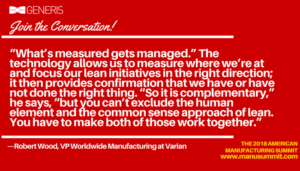 With rapid innovation and the proliferation of data, technology promises improvements in nearly every area of manufacturing. The implications for increased efficiency are tremendous, but our experts warn that technology will not solve all your lean problems.
With rapid innovation and the proliferation of data, technology promises improvements in nearly every area of manufacturing. The implications for increased efficiency are tremendous, but our experts warn that technology will not solve all your lean problems.
At our 2016 American Manufacturing Summit, we spoke to some lean leaders about how you should think of technology within the framework of your lean initiative. The consensus is that while technology can be a great complement to your lean initiatives, providing you with insights you wouldn’t otherwise have, it cannot entirely replace the human aspects of lean. Learn what they had to say on this topic.
Mohammed Abuali, CEO of Forcam, a global leader in IoT transformation, spoke of the common problem of disconnectivity between what is happening on the shop floor and what is happening on the top floor. He said while he truly believes that technology complements lean operations, it is important to find the right solution that can complement lean transformation and tell you what is happening on the shop floor. Therefore, you need to clearly define your goals and identify how technology can support those.
Robert Wood, VP, Worldwide Manufacturing at Varian, reminded us of the adage “what’s measured gets managed.” The technology allows us to measure where we’re at and focus our lean initiatives in the right direction; it then provides confirmation that we have or have not done the right thing. “So it is complementary,” he says, “but you can’t exclude the human element and the common sense approach of lean. You have to make both of those work together.”
Michele Calbi, former VP, Lean Transformation at Navistar, agrees and adds that the data you gather from technology should work complementary with the Gemba walk specifically. She says sometimes you can see what’s going on in the data, but sometimes it’s in the process. “You still need to talk to people and walk the floor.”
The issue is summed up nicely by Mark Reich, COO of the Lean Enterprise Institute, who previously spent 23 years at Toyota in both the US and Japan. He speaks to the importance of always asking “What problem are we trying to solve?” Sometimes we jump to technology as a solution, but if the problem is cultural, then technology is probably not the answer.
For more insights from lean implementation experts, join us at the 2018 American Manufacturing Summit. VIEW THE PROGRAM